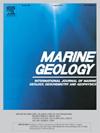Provenance shift of the abyssal plains in the Southwest sub-basin of the South China Sea at ∼ 8 Ma: Tectonics & climate changes implication
Abstract
Tectonic processes and climatic changes are recognized as two major drivers of erosion along the southeastern margin of the Tibetan Plateau and consequently are the main factors controlling depositional patterns along the margins of the South China Sea. However, the role of tectonics and climate in governing the types and patterns of sedimentation in the abyssal plains is relatively little known. The results of International Ocean Discovery Program (IODP) drilling in the abyssal plains of the Southwest sub-basin of the South China Sea show that the multi-trace element and rare earth element (REE) character of sediments older than ∼8 Ma are in disorder. εNd(0) and 87Sr/86Sr values exhibit large fluctuations, which implies temporally variable sediment sources during the early post-spreading stage of the South China Sea. High εNd(0) and low 87Sr/86Sr values and abundant Cenozoic (13–35 Ma) zircon grains in the sediments suggest relatively juvenile sources for their origins, such as the Cagayan Ridge and Palawan Block in the south before ∼8 Ma. Multi-trace element and REE patterns of sediments younger than ∼8 Ma are more uniform. Low εNd(0) and high 87Sr/86Sr values of the sediments indicate that more continentally-derived sediments were transported to the abyssal plain. Coastal rivers in SE Vietnam, and the Mekong and Red Rivers in the west gradually became the major detrital sources of abyssal sediments in the Southwest sub-basin after ∼8 Ma. The switching of the sediment sources from the south to the west is consistent with the progressive uplift of the Vietnamese Central Highlands (VCH) and the SE Tibetan Plateau margin during the Late Miocene. The strengthened summer monsoon since ∼5 Ma affected not only the marginal basins, but also the deep abyssal basins. We argue that the regional tectonics shaped and controlled the shift of provenance and sediment routing system, whereas the East Asian monsoon affected the sediment flux to the abyssal plains of the Southwest sub-basin in the South China Sea.

 求助内容:
求助内容: 应助结果提醒方式:
应助结果提醒方式:


